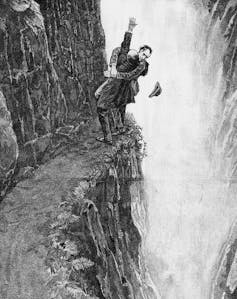The rise of the autistic detective – why neurodivergent minds are at the heart of modern mysteries
- Written by Soohyun Cho, Assistant Professor at the Center for Integrative Studies in the Arts & Humanities, Michigan State University
There never seems to be a shortage of good crime shows on TV, and network television is teeming with detectives who think – and act – differently.
This fall, new seasons of “Elsbeth[1],” “High Potential[2],” “Patience[3]” and “Watson[4]” have aired, and they all feature leads who share similar characteristics: They’re outsiders, they’re socially awkward, they can be emotionally distant, and their minds operate in unconventional ways.
In fact, they all possess traits that align with what many people now associate with neurodivergence – what scholar Nick Walker defines as[5] “a mind that functions in ways that diverge significantly from the dominant societal standards of ‘normal.’”
As a scholar of popular culture[6], I’ve long been fascinated by this recurring character type – detectives who might, today, be diagnosed as having autism spectrum disorder.
While researching my forthcoming book, “The Autistic Detective,” I’ve come to realize that most detectives in popular culture – yes, even Sherlock Holmes – exhibited neurodivergent characteristics, long before the term existed.
The thin line between genius and madness
In the late 19th century, when Sherlock Holmes was created, there was widespread scientific interest in the workings of the mind, particularly the thin line between genius and madness.
British psychologist James Sully[7] described “men of genius[8]” as exhibiting “intellectual or moral peculiarities which are distinctly symptomatic of mental disease,” naming Edgar Allan Poe as an example of the “tragic fatefulness of geniuses.” Italian criminologist Cesare Lombroso[9], meanwhile, proposed that madness, genius and criminality were all closely intertwined.
Such a fascination with exceptional minds – and the idea that madness and genius are two sides of the same coin – fed into the heart of detective fiction. And although later scholars have criticized the linking of neurodivergence[10] to pathology, violence or genius, the trope remains common in popular culture, where it’s often used to signal the exceptional mind of a detective figure.
Now, however, many fans are able to connect these characteristics to specific diagnostic labels. According to CDC data from April 2025, autism diagnoses in U.S. children have risen sharply over the past two decades – from about 1 in 150 in 1998 to roughly 1 in 31 today[11]. This reflects not only a broadened definition of the autism spectrum but also signals greater public awareness and acceptance of neurodivergence.
That growing understanding has led to renewed interest in Holmes. From online fan forums to The New York Times[12], people have debated whether Holmes might be autistic[13], wondered whether another label would be more appropriate[14], or highlighted the futility of trying to diagnose a fictional character[15].
Super intelligence and social dysfunction
That said, it’s hard not to see some neurodivergent traits in Sherlock Holmes and other fictional detectives.
Tunnel vision[16], pattern recognition[17] and attention to detail[18] are all traits that could be exhibited by autistic people.
Holmes was fixated on minute details: One story highlighted how he authored a study on the ashes of 140 different varieties[19] of pipe, cigar and cigarette tobacco. He had an unmatched talent for noticing overlooked details and piecing together disparate clues. And he was obsessed with forensic science.
He could also come off as cold. As Holmes declared in “The Sign of the Four[20],” “Emotional qualities are antagonistic to clear reasoning.”
In Edgar Allan Poe’s 1841 short story “The Murders in the Rue Morgue[21],” which is widely considered the first detective fiction story, the protagonist, C. Auguste Dupin, also hyperfocuses on small details, reasons through “pure logic” and is socially reclusive – all qualities displayed by Holmes.
Even Dr. Watson, Holmes’ sidekick, noticed the resemblance.
“You remind me of Edgar Allen Poe’s Dupin,” he tells Holmes in “A Study in Scarlet[22].” “I had no idea that such individuals did exist outside of stories.”

When Sherlock Holmes creator Arthur Conan Doyle famously killed off the detective at Reichenbach Falls[24] in his 1893 story “The Final Problem[25],” there was so much public outrage that the author was eventually forced to bring him back from the dead[26].
These 19th-century Sherlock enthusiasts were predecessors to today’s media fandoms[27]. Their level of devotion, unlike anything previously seen for a fictional character, was a testament to the power of Doyle’s formula: an extraordinary investigator with savantlike cognitive abilities who upholds logic over emotion, thrives in solitude and yet still depends on his companion – in Holmes’ case, Dr. Watson, who serves as an emotional counterbalance.
In the 21st century, that formula has been revived in wildly popular[28] TV shows such as “Bones[29],” “Criminal Minds[30]” and “Sherlock[31].”
In 2016, “Sherlock” co-creator Steven Moffat told the BBC[32], “Doyle began the idea that super-intelligence comes at the price of some kind of social dysfunction, something that we’ve grasped as a narrative possibility ever since.”
In other words, the more eccentric – or socially dysfunctional – a detective is, the more ingenious the hero seems.
A new era for the detective
Detective fiction might have started as a way to explore the deviant, non-normative minds of detectives and the criminals they pursued. But it has since become a space for neurodivergent self-representation.
Today, scholars, fans, reviewers and scientists openly discuss diagnostic labels for fictional characters[33]. This surge in interest coincides with a rise in research on portrayals of autism in the media[34] and a growing number of autistic voices examining how those portrayals shape public understanding[35].
Disability scholars have long warned of disabled characters being used as mere plot devices[36] and have criticized the lack of diversity in representations of detectives who appear to be autistic[37] on screen.
Yet many of the new shows push back against some of the stereotypes[38] of autistic people as cold, lonely and incapable of affection. Instead, they have friends. They have romantic partners. They’re empathetic.
The series “Elsbeth” and “High Potential” center on quirky, intelligent female investigative leads who appear to be on the autism spectrum. In HBO’s 2020 miniseries “The Outsider[39],” detective Holly Gibney appears as one of the first Black, autistic female detectives on television.
While most of these characters aren’t explicitly identified as autistic in their shows, “Extraordinary Attorney Woo[40]” features a female attorney whose diagnosis is openly discussed by the show’s characters.
‘Extraordinary Attorney Woo’ is a Korean series centered on an autistic, early-career attorney.The British-Belgian series “Patience,” meanwhile, is the first detective show to feature an explicitly autistic character played by a neurodivergent actress, Ella Maisy Purvis.
“It was really important to me that she wasn’t this kind of robotic, asexual drone,” Purvis told the Big Issue in 2025[41]. “Patience is highly empathetic. She cares so much about her job and the people around her. It’s just expressed in a different way.”
These varied portrayals coincide with the rise of online fan communities where neurodivergent fans share what these stories mean to them. If the archetypal detective once tried to “make sense” of neurodivergent minds, today’s neurodivergent fans and creators are now having a hand in shaping them.
Perhaps most importantly, they no longer have to wonder whether they’re being represented on screen.
References
- ^ Elsbeth (www.imdb.com)
- ^ High Potential (www.imdb.com)
- ^ Patience (www.imdb.com)
- ^ Watson (www.imdb.com)
- ^ what scholar Nick Walker defines as (neuroqueer.com)
- ^ As a scholar of popular culture (scholar.google.com)
- ^ James Sully (sk.sagepub.com)
- ^ described “men of genius (en.wikisource.org)
- ^ Cesare Lombroso (www.ebsco.com)
- ^ have criticized the linking of neurodivergence (iupress.org)
- ^ from about 1 in 150 in 1998 to roughly 1 in 31 today (theconversation.com)
- ^ The New York Times (www.nytimes.com)
- ^ might be autistic (www.psychologytoday.com)
- ^ another label would be more appropriate (globalcomment.com)
- ^ the futility of trying to diagnose a fictional character (wellingtongoose.tumblr.com)
- ^ Tunnel vision (embrace-autism.com)
- ^ pattern recognition (embrace-autism.com)
- ^ attention to detail (www.open.edu)
- ^ a study on the ashes of 140 different varieties (www.gutenberg.org)
- ^ The Sign of the Four (www.gutenberg.org)
- ^ The Murders in the Rue Morgue (www.gutenberg.org)
- ^ A Study in Scarlet (www.gutenberg.org)
- ^ Historical Picture Archive/Corbis via Getty Images (www.gettyimages.com)
- ^ at Reichenbach Falls (alpinehikers.com)
- ^ The Final Problem (sherlock-holm.es)
- ^ to bring him back from the dead (booksofbrilliance.com)
- ^ were predecessors to today’s media fandoms (www.cambridge.org)
- ^ wildly popular (www.taylorfrancis.com)
- ^ Bones (www.imdb.com)
- ^ Criminal Minds (www.imdb.com)
- ^ Sherlock (www.imdb.com)
- ^ told the BBC (www.bbc.com)
- ^ openly discuss diagnostic labels for fictional characters (www.taylorfrancis.com)
- ^ portrayals of autism in the media (utpress.utexas.edu)
- ^ how those portrayals shape public understanding (doi.org)
- ^ being used as mere plot devices (theconversation.com)
- ^ detectives who appear to be autistic (the-art-of-autism.com)
- ^ push back against some of the stereotypes (riviste.unimi.it)
- ^ The Outsider (www.imdb.com)
- ^ Extraordinary Attorney Woo (www.imdb.com)
- ^ Purvis told the Big Issue in 2025 (www.bigissue.com)
Authors: Soohyun Cho, Assistant Professor at the Center for Integrative Studies in the Arts & Humanities, Michigan State University





